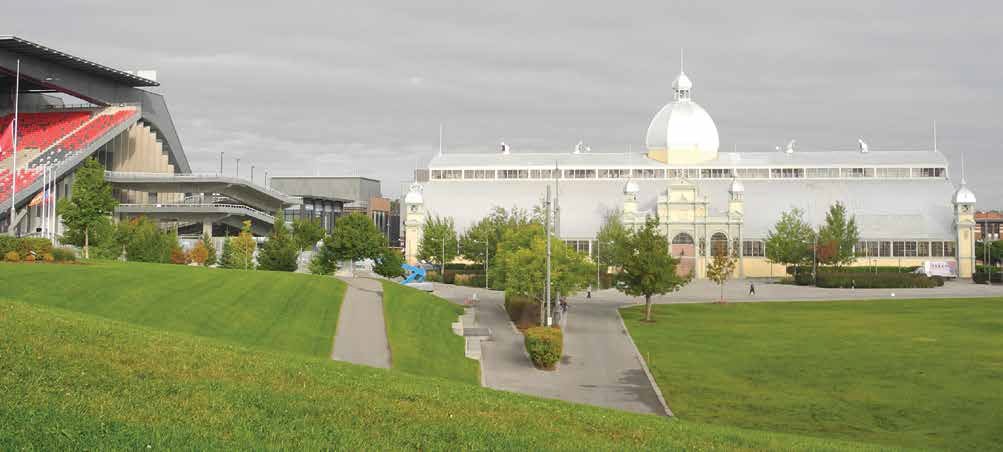Alexandra Gruca-Macaulay
On November 9, 2023, Ottawa City Council agreed to fund OSEG’s proposal to further redevelop Lansdowne Park – a plan that, at last estimate, will require $437.7 million of new City spending (the City has already spent $210 million on Lansdowne), and $331.3 million of new 40-year City debt (the City still has $100 million of Lansdowne debt outstanding).
The complexity of the “Lansdowne 2.0” proposal has tended to obscure the fact that at its heart sits a group of disenchanted private investors who have presented the City with a “take it or leave it” plan. Given the plan’s staggering cost, and lessthan-transparent presentation of information, it may be helpful to step beyond OSEG’s well-orchestrated marketing campaign and take a closer look at what the proposal actually involves.
While OSEG has claimed that a new event centre and stadium are key to financial sustainability, the projections presented in the staff report tell a different story. In fact, in the 2.0 plan, the new Event Centre and Stadium are projected to lose $164.8 million. The 67s are projected to lose $4.5 million. The Redblacks have lost $10.5 million over the past 9 years, but OSEG’s projections assume a dramatic turnaround to an operating profit of $150.7 million. EY’s due diligence underscored that “improved team performance [i]s critical for achieving the projected profitability.” The Redblacks ended their 2023 season with 4 wins and 14 losses. But even if OSEG’s projections were to hold, the teams and sporting facilities together are still projected to lose about $20 million.
At the end of the day, as has been the historical reality with Lansdowne 1.0, the LLP’s financial sustainability rests on the performance of the retail component. To date, the retail component has not managed to generate enough profit to cover its retail loan payments and to offset the losses of the other three business lines. Whether an additional 2% of retail space will be enough to turn partnership losses around remains an open question.
During the Lansdowne 2.0 November committee meetings, a few councillors who voted “yes” for OSEG’s proposal engaged extensively with one presenter who spoke of the importance of tech companies to the Ottawa area, and specifically the role of Lansdowne in attracting such businesses to its offices. The presenter singled out a company called Field Effect, which has its office at Lansdowne, and the Mayor then added “I’m glad that you brought up Field Effect.” However, neither the Mayor nor the Councillors seemed to be aware that the Office Component at Lansdowne is not one of the LLP’s operating components (retail is, office is not). Lansdowne’s Office Component is owned by outside investors. In fact, as profiled in the Ottawa Business Journal in 2022, Field Effect leases its office at Lansdowne from BTB, a commercial real estate investment company that is traded on the TSX. City staff did not correct the Councillors’ confusion.
The 2.0 plan approved by Council would see the City build a new arena where the berm at the end of the football field now sits resulting in the loss of 58,000 square feet of public park greenspace. According to Mr. Goudie, the berm is called “Cheapskate Hill” because people can watch games “for free”… “If you’re watching a game on TV from Ottawa, there’s always a shot of Cheapskate Hill and people sitting with their picnic baskets, and their blankets watching a game.” For other residents, the berm is a treasured part of the park and known by many as the Great Toboggan Hill. Its loss will be acutely felt.
Last year’s Lansdowne 2.0 proposal suggested that there may be a green grass roof on the arena, but in a cost-saving measure this feature has since been removed from the current concept design. Also removed is a roof over the north-side stadium stands, which currently has a roof but which will be open to the elements under the Lansdowne 2.0 plan.
The City would sell a parcel of land to a private developer (not OSEG, which exists solely as an investment vehicle for the LLP; the Lansdowne 1.0 private developer of the towers was Minto—a development company owned by the Greenberg family) and use the estimated $39 million from the sale to help offset its $437.7 million in project costs. The developer would construct two residential towers, at least one, if not both, with a height of forty storeys. While the plan tabled on November 2 designated only 10% of the proceeds from the sale to affordable housing, a motion restored the amount required under City policy – 25%. The $17.4 million of yearly debt payments that will be needed for 40 years will require an annual City budgeted debt accrual reserve, as well as annual drawdowns on the City’s parking reserves. The staff report also advises that as a “legacy” project, the amount by which property taxes could be raised to cover Lansdowne debt servicing is unlimited.
Before Council’s vote on the Lansdowne 2.0 proposal, Councillor Menard summed up: “We would be losing public space and beloved buildings that have decades of life left and well-used green space to pay for new infrastructure that a private partner says they need to be more financially stable. They need to make more money or at least stop losing some of that money here and that’s, at the end of the day, what this is all about….[I]f this project debt is too expensive to include things we agreed to prioritize as a Council…then maybe this project is simply too expensive to be a priority for us right now, maybe we shouldn’t be considering this public debt at all…how can we have enough money for a stadium but not enough to house people in this harsh winter city, or to have proper buildings for Emergency Shelters, or to avoid service cuts to our transit system? I believe this decision will be one that this Council will come to regret…”
Councillors Menard, Bradley, Devine, Troster, Johnson, Brockington, Kavanagh, Leiper, and King voted no to 2.0, the Mayor and the remaining Councillors voted yes.
After receiving Council’s approval, Mr. Goudie sent a note to thank Lansdowne supporters. Once a few remaining items are completed, he told them, “the vault will be unlocked” and construction will begin.
This concludes Alexandra Gruca-Macaulay’s in-depth editorial analysis of the cost implications of City Council’s recent approval of the Lansdowne 2.0 project. Part 1 of the analysis can be viewed on our website at: www.mainstreeter.ca or by scanning the QR Code below.








